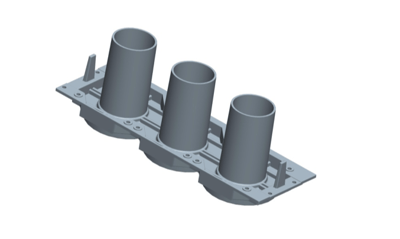 The term thermoset describes a polymer-based material that is insoluble and non-melting. This is in contrast to a thermoplastic material, which is generally soluble and can be melted. While both types of materials can be classified as polymers, the primary difference lies in their structures. In a thermoset, a pre-polymer, or backbone, resin is reacted with a crosslinking agent under heat and pressure to form a crosslinked network. Thermoset network formation can also be achieved without heat and pressure by using radiation or room temperature initiators / promoters. Conversely, thermoplastic materials do not contain a crosslinked network – a difference that has many implications and forms the basis for general use profiles of these two classes of polymer materials.
The term thermoset describes a polymer-based material that is insoluble and non-melting. This is in contrast to a thermoplastic material, which is generally soluble and can be melted. While both types of materials can be classified as polymers, the primary difference lies in their structures. In a thermoset, a pre-polymer, or backbone, resin is reacted with a crosslinking agent under heat and pressure to form a crosslinked network. Thermoset network formation can also be achieved without heat and pressure by using radiation or room temperature initiators / promoters. Conversely, thermoplastic materials do not contain a crosslinked network – a difference that has many implications and forms the basis for general use profiles of these two classes of polymer materials.
The most recognizable difference between the two major classes of materials is that thermoplastic materials can be re-shaped, re-formed, and recycled even after they have been processed [molded, extruded, etc.]. This malleability stems from the fact that the change a thermoplastic material undergoes when being processed is physical. For example, think of a thermoplastic material as a wax candle. The candle is solid, can be formed into myriad shapes, and has its own unique properties. This same candle can also be melted and re-formed into a vastly different shape while generally retaining the same properties. The opposite is true for a thermoset material. When processed, a thermoset material undergoes a chemical change; that is, a chemical reaction occurs as the crosslinking agent chemically bonds to the polymer backbone resin. Once this bonding occurs, the material cannot be melted, reprocessed, or re-formed. The presence of a chemically bonded network imparts very desirable properties, which is why thermoset polymers are the material of choice in many applications.
Regarding properties, thermoset materials are in general stronger than thermoplastic materials due to the network described above. They are also typically higher in modulus, or stiffness, and have unique deformation responses when subjected to mechanical loading. Furthermore, the crosslinked nature of thermosets gives them superior temperature stability and enables them to display a generally stable property response over a much broader temperature range than the range displayed by thermoplastics. Since the covalent bonds between polymer chains in a thermoset cannot be easily broken, they can perform in chemical / corrosive service environments, and consequently are widely used in the chemical, energy / mining, and wastewater industries.
Unlike thermoplastic materials, thermoset systems offer much broader custom formulation flexibility. Whether using reinforcing fibers, functional fillers, or performance-enhancing additives, the rheological nature of thermosetting base polymers enables a much higher loading of additives. This higher loading potential allows for broader custom compound formulation and more tailorable properties – and hence a higher level of functionalization. This ability to achieve a high level of customization gives both the specifying engineer and the manufacturer a range of thermoset options to conquer any performance challenge.


